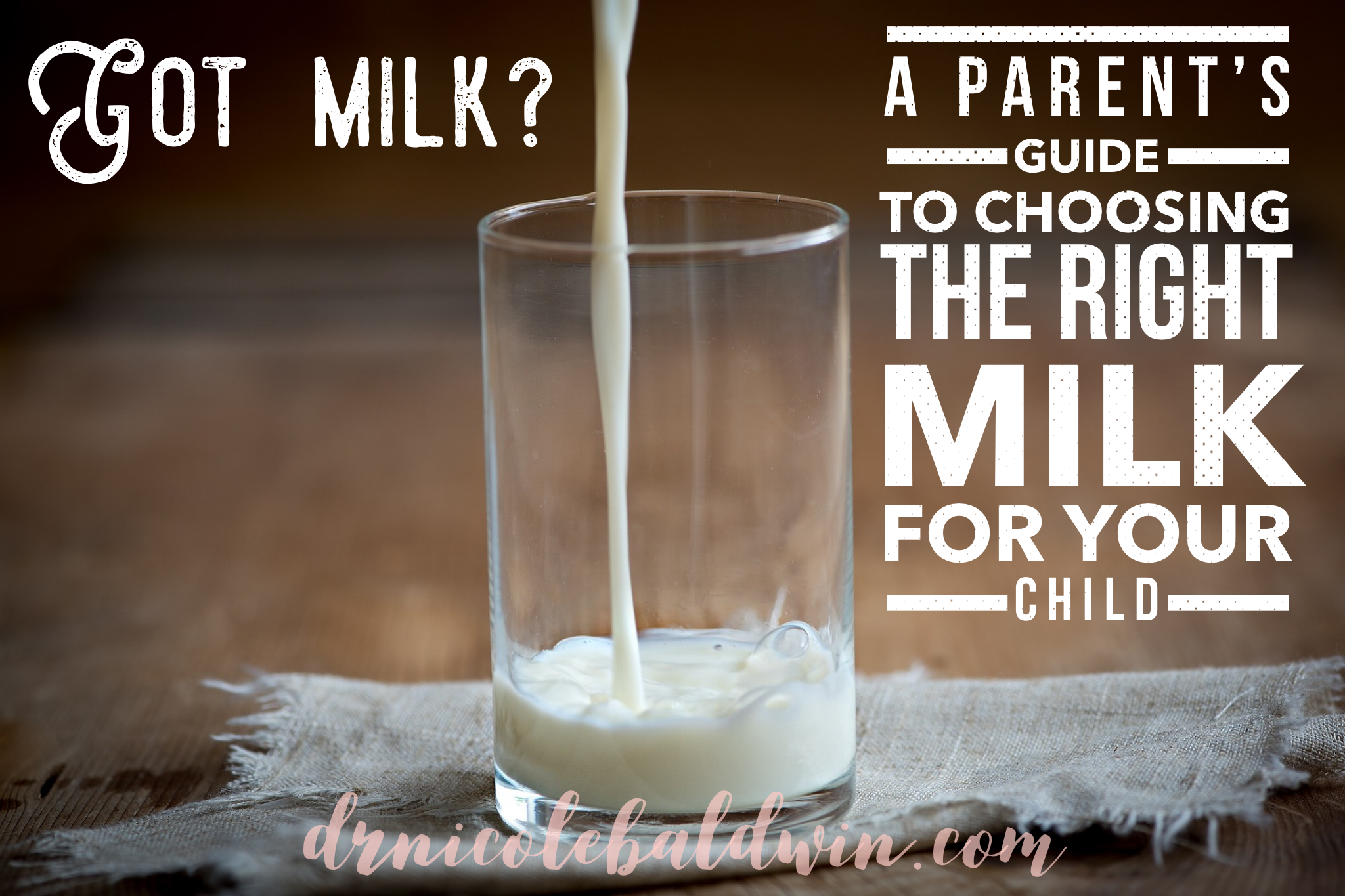
Got milk? A Parent’s Guide to Choosing the Right Milk for Your Child
We’ve all heard it said…milk, it does a body good. But what exactly makes milk so great?
- Regular consumption of milk in childhood and adolescence helps prevent osteoporosis.
- Diets high in milk and dairy products have been shown to reduce childhood obesity, type 2 diabetes, and facilitate weight loss when combined with a healthy diet.
- Drinking low fat milk products reduces risk of high blood pressure and stroke.
- Milk may even protect against certain types of cancers.
There are lots of different types of milk on the shelf and it can be confusing to know which one is best for your family (even as a pediatrician). After researching the current data about the various milk and milk alternatives available and consulting with a registered dietician on the subject, I hope to shed some light on the subject for you.
First, let me say that I am addressing milk intake for children OVER 12 months of age. Before 12 months of age, infants should be fed either breastmilk or iron fortified formula as guided by their health care provider.
For children OVER 12 months of age, there are many factors to consider:
- conventional vs. organic cow’s milk
- whole milk vs. lower fat milk
- cow’s milk vs. non dairy alternatives
If you find yourself in the dairy aisle wondering which milk is best for your child, here is what you need to know:
Conventional vs. Organic Cow’s Milk
Long story short: save your money and buy conventional milk. The American Academy of Pediatrics (AAP) states that the differences between the two are minimal. There is no data at this point to suggest that organic milk is significantly better than conventional milk. For more information, check out these resources:
Organic Foods: Health and Environmental Advantages and Disadvantages http://pediatrics.aappublications.org/content/pediatrics/early/2012/10/15/peds.2012-2579.full.pdf
Organic vs. Conventional Milk: Some Considerations on Fat-Soluble Vitamins and Iodine Content https://www.mdpi.com/2306-5710/3/3/39/htm
Whole Milk vs. Lower Fat Milk
The AAP recommends 2 servings of whole milk (16 oz) per day for children between the ages of 12-24 months. Younger children need the added fat content for brain development. For children at risk for obesity or with a family history of cardiovascular disease, the AAP recommends 1-2% milk between age 1-2 years. If you are unsure about your child’s risk, please talk with your health care provider. After age 2 years, 2-3 servings of lower fat milk (skim or 1%) is recommended (maximum of 24 oz per day).
Cow’s Milk vs. Non Dairy Alternatives
If your child does not have a DIAGNOSED milk protein intolerance or cow’s milk allergy, then cow’s milk is the best for them. Why?
- Most non dairy milk products contain significantly less protein per serving than cow’s milk (the exceptions to this are soy milk and pea protein milk).
- The protein in cow’s milk is high-quality protein, containing all essential amino acids.
- While many non dairy milk products are fortified with micronutrients to appear similar to cow’s milk, the bioavailability of those products have not yet been shown to be equivalent to that of cow’s milk (meaning – the nutrients may be IN the product, but that doesn’t mean that they are actually ABSORBED into the body).
For children with a confirmed milk allergy. What non dairy milk is best for them?
Each child’s situation is unique and it is IMPERATIVE that you discuss your options with your child’s health care provider, allergist, and/or registered dietician.
Things to consider with non dairy milk alternatives:
Protein content – whole milk contains just over 7 grams of protein per serving; most other non dairy milks contain significantly less (the exceptions being soy and pea protein milk which have the same or more protein per serving as cow’s milk). For example, almond milk only contains 1 gram of protein per 8 oz serving. For many children, milk may be the main source of protein in their diets, which is why it’s important to discuss the best option with your child’s physician.
Sugar content – if you go for the “unsweetened” variety, you will typically get less sugar than cow’s milk per serving – however many parents buy the “sweetened” variety because it tastes better…but beware, many sweetened milks can contain up to 20 grams of sugar per serving (which rivals the sugar content in juice).
Don’t fear the soy!
There seems to be a bit of concern regarding soy milk and the “estrogen content.” I will fully admit that before I did more research, I was also fearful – however consider my opinion CHANGED! A very thorough review of the literature regarding soyfoods shows that not only do they reduce the risk of cardiac disease, breast and prostate cancer but they also have benefits with skin health and can even alleviate depression symptoms. While the research is limited in children, it appears that soy products DO NOT cause a shift in hormones or in puberty. So – if you are seeking a non dairy source of milk for your child – soy is a great way to go!
For a deeper dive into the benefits of soyfoods, check out this article: https://www.ncbi.nlm.nih.gov/pmc/articles/PMC5188409/
For more detail about non dairy milk products, check out this post from the AAP: https://www.healthychildren.org/English/healthy-living/nutrition/Pages/Milk-Allergy-Foods-and-Ingredients-to-Avoid.aspx
This article is also a great review of everything you ever wanted to know about milk alternatives: https://med.virginia.edu/ginutrition/wp-content/uploads/sites/199/2014/06/January-18-Milk-Alternatives.pdf
So – bottom line – for MOST children cow’s milk is your best bet. If your child has a diagnosed milk allergy, then unsweetened soy or pea protein milk are the best replacements (provided your child does not have an allergy to any of the contents). Remember to always discuss questions or concerns with your child’s health care provider.
Special thanks to Amy Reed, RD for her help with this topic.





3 Comments
anju
what about goat’s milk.
Dr. Nicole Baldwin
Great question! Goat’s milk is not safe for children under the age of 2 due to it’s higher protein and sodium content (that little kidneys just can’t handle). Raw or unpasteurized milk products are never recommended due to the increased risk of infection. Other than that, for a healthy child over 2, drinking pasteurized goat’s milk should be OK. Always check with your health care provider about your child’s specific situation.
Lydia G
Some children can handle yogurt better than milk. The bacteria break it down and consume the lactose. Yogurt is just as nutritious as milk. As with the alternative milks, watch the sugar content. Kefir is also awesome and now readily available at the grocery store.